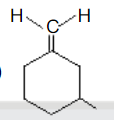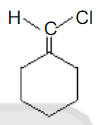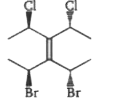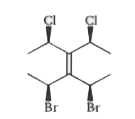Which of the following compound will show geometrical isomerism?




To determine which compound will show geometrical isomerism, we need to analyze the structure of each compound provided in the options. Geometrical isomerism occurs in compounds with a double bond (typically C=C) where each carbon atom of the double bond has two different groups attached to it.
1. Identify the Double Bond: Look for the presence of a double bond in each compound. Geometrical isomerism can only occur in compounds with at least one double bond.
2. Examine Each Carbon of the Double Bond: For each carbon atom involved in the double bond, check the groups attached to it. Each carbon must have two different groups attached for geometrical isomerism to be possible.
3. Analyze the First Compound (Option A):
- Carbon 1: Attached groups are Cl and H (different).
- Carbon 2: Attached groups are CH3 and H (different).
- Conclusion: Both carbons have different groups attached, so this compound can show geometrical isomerism.
4. Analyze the Second Compound (Option B):
- Carbon 1: Attached groups are Cl and H (different).
- Carbon 2: Attached groups are CH2 and CH2 (same).
- Conclusion: One carbon does not have different groups, so this compound cannot show geometrical isomerism.
5. Analyze the Third Compound (Option C):
- Carbon 1: Attached groups are H and H (same).
- Carbon 2: Attached groups are CH2 and CH2 (same).
- Conclusion: Both carbons do not have different groups, so this compound cannot show geometrical isomerism.
6. Analyze the Fourth Compound (Option D):
- Carbon 1: Attached groups are Cl and H (different).
- Carbon 2: Attached groups are CH2 and CH2 (same).
- Conclusion: One carbon does not have different groups, so this compound cannot show geometrical isomerism.
Final Answer:
The only compound that can show geometrical isomerism is Option A.
- Carbon 1: Attached groups are Cl and H (different).
- Carbon 2: Attached groups are CH3 and H (different).
- Conclusion: Both carbons have different groups attached, so this compound can show geometrical isomerism.
- Carbon 1: Attached groups are Cl and H (different).
- Carbon 2: Attached groups are CH2 and CH2 (same).
- Conclusion: One carbon does not have different groups, so this compound cannot show geometrical isomerism.
- Carbon 1: Attached groups are H and H (same).
- Carbon 2: Attached groups are CH2 and CH2 (same).
- Conclusion: Both carbons do not have different groups, so this compound cannot show geometrical isomerism.
- Carbon 1: Attached groups are Cl and H (different).
- Carbon 2: Attached groups are CH2 and CH2 (same).
- Conclusion: One carbon does not have different groups, so this compound cannot show geometrical isomerism.
The only compound that can show geometrical isomerism is Option A.
Similar Questions
Knowledge Check
Which of the following compound can show geometrical isomerism ?
A B
B C
C D
D
Which of the following compound will not show geometrical isomerism across the it π-bond ?
A B
B C
C D
D
Which one of the following compounds will show geometrical isomerism ?
ACH3−CH=CH2BCH3−C∣CH3=CH2CCH3−C∣CH3=CHDDCH3=CH=CHD
Which of the following compounds will not show geometrical isomerism?
View SolutionWhich of the following compound will show optical isomerism
View SolutionWhich of the following compound will exhibit geometrical isomerism ?
View SolutionWhich of the following compounds shows geometrical isomerism (G.I.)?
a. But−2− ene
b. 3− Methyl but −2−enoic acid
c. 3− Methyl pent −2− enoic acid
d. 3− Phenyl prop −2− enoic acid.
View SolutionWhich among the following compounds will show geometrical isomerism.
View Solution
